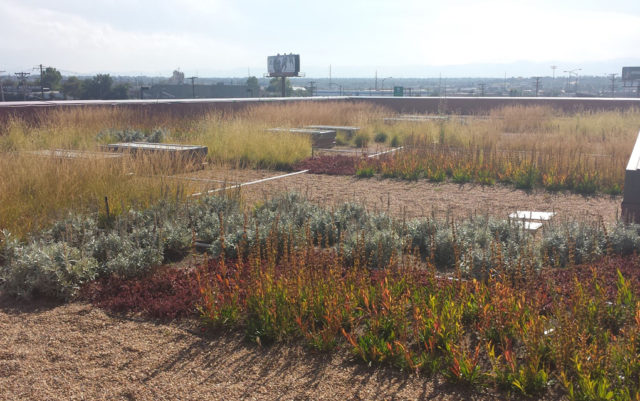
Denver’s skyline is picturesque, with downtown buildings framed by snowcapped mountains and sunny skies. But a measure that went into effect Jan. 1 requiring rooftop gardens will soon have the city growing more green.
While urban landscaping adds aerial aesthetic to a cityscape, this is an environmental matter championed by a small group of residents to address climate change concerns in the Mile High City.
Denver’s Initiative 300, known locally as the Green Roof Initiative, mandates all new buildings (or additions or remodeling to buildings) over 25,000 square feet to cover 20 to 60 percent of their rooftops with gardens. It passed with 54 percent of the vote in November.
Brandon Rietheimer spearheaded the initiative with five friends in early 2017, wanting to do something for the climate, specifically the problems associated with air quality, temperature and dirty waterways.
“Looking at Denver’s environmental scorecard there are all these problems you wouldn’t think an otherwise environmentally friendly city would have,” he says. “In looking for one all-encompassing thing, green roofs really addressed all those issues.”
According to the National Park Service, green roofs are ecologically beneficial, retaining up to 80 percent of storm-water runoff and lowering roof temperatures. Vegetation also helps lower the urban heat island effect (UHIE), when heavily developed regions absorb heat in buildings’ surfaces, making metro areas significantly warmer than surrounding rural areas.
In a 2014 study, Denver had the third worst UHIE in the country. Downtown is, on average, 5 degrees — and can be as much as 23 degrees — warmer than the rural suburbs.
Most language for the Green Roof Initiative was adapted from Toronto’s Green Roof Bylaw, which has been in place since 2009 and was the first of its kind in North America. San Francisco, which enacted a similar policy this year, shared research and study materials with Denver city officials for fine-tuning.
While alleviating climate stressors and beautifying buildings sound ideal, there has been significant resistance to the Green Roof Initiative.
Denver Mayor Michael Hancock spoke out against the mandate. During the campaign process, the Denver Metro Chamber of Commerce, the Downtown Denver Partnership and several real estate and development companies formed an opposition group called Citizens For a Responsible Denver. They raised roughly $250,000 trying to stop the measure from passing, nearly 12 times the $21,000 raised by supporters.
“The fact that we’re grassroots and big corporations were against us, I think that rallied people together,” Rietheimer says. “It was really an opportunity for the people of Denver to vote their values, you know, and say, ‘We’re not going to be outvoted by the developers.’”
Much of the contention was due to the quick implementation timeline, which didn’t allow adequate time to establish costs and protocols, says Michael Gifford, CEO of the Associated General Contractors of Colorado, one of the associations opposed to the Green Roof Initiative.
“We’re willing to make it work, we just want to make it right the first time,” Gifford says.
Money is also a factor for those who oppose the initiative. The mandate will increase building and maintenance costs for developers and owners.
The average green roof installation costs $17 to $23 per square foot, according to Andy Creath, owner of installation company Green Roofs of Colorado. Upkeep requires about a dozen yearly reviews, costing roughly $1 per square foot for the first year and $.50 the second year.
While the up-front costs are about 2.5 times higher than those of traditional roofs, a recent study done by the Green Infrastructure Foundation found there will be a return investment in approximately six years, and that by 2058 an added 57.5 million square feet of green rooftops will have generated $1.85 billion in savings.
Once green roofs are fully functioning gardens, the shrubbery insulates a building, saving up to 15 percent on energy expenses. Water absorbing plants add longevity to the roofs, meaning green roofs need to be replaced much less frequently than traditional rooftops.
“The problem is [the developers] want to buy a building and sell it in a year or two, so they don’t get the long-term financial benefits,” Creath explains. “They’re saying, ‘Why would we put in these environmental benefits and other measures that are going to cost us money and not get the payback?’”
Rietheimer also understands the requirements may dissuade development. He is working closely with the City and stakeholders to specify exemptions, which will include schools, residential units under four stories, energy star-rated buildings and developers who qualify that pay a cash-in-lieu fee.
There will be a public hearing Jan. 17 for comments, questions and suggestions about the ordinance and its rules, and the City will vote on amendments in May or June.














